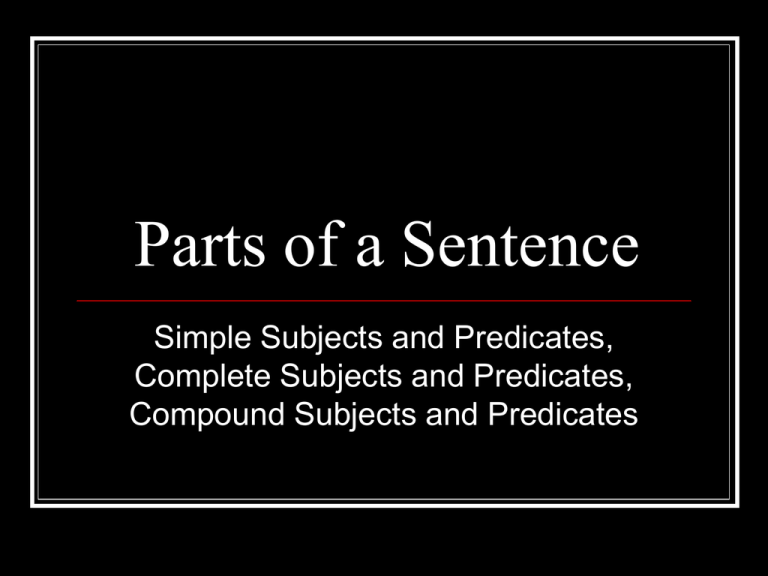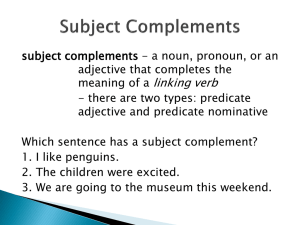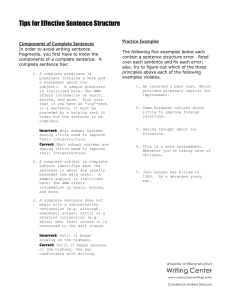Parts of a Sentence
advertisement

Parts of a Sentence Simple Subjects and Predicates, Complete Subjects and Predicates, Compound Subjects and Predicates I. Sentences and Fragments A. B. C. Subject Part of a sentence names whom or what the sentence is about. Predicate part of the sentence tells what the subject does or has. It can also describe what the subject is or is like Sentence Fragment does not express a complete thought. 1. Timmy ate the cake. II. Complete Subjects and Predicates The Simple Subject in the main of the most important word or group of words in the complete subject. The Simple Predicate is the main word or group of words in the complete predicate. A. B. 1. SIMPLE: The happy boy / ate his large birthday cake. The Complete Subject includes all the words in the subject of a sentence. The Complete Predicate includes all of the words in the predicate of a sentence. C. D. 1. COMPLETE: The happy boy / ate his large birthday cake. III. Compound Subjects and Predicates A. B. A Compound Subject is two or more simple subjects that have the same predicate. A Compound Predicate is two or more simple predicates, or verbs, that have the same subject. IV. Compound Subjects A. B. C. D. Timmy and Susie watched a movie together. The fish and the cat played tag. Both the soccer and football teams play tonight. Daring feats and thrilling chases are exciting. V. Compound Verbs A. B. C. The hero conquered and captured the city. Odysseus outsmarted and outmaneuvered his enemies. Boo Radley scared and mystified Jem and Scout. VI. Compound Predicates A. B. C. Faulkner’s stories engage the imagination and excite readers. Tommy stopped the car and changed the tire. Susie cut her hair and then bought a new dress. VII. Simple and Compound Sentences A. B. A Simple Sentence has one subject and one predicate. A Compound Sentence is a sentence that contains two or more simple sentences joined by a comma and a coordinating conjunction or by a semicolon. Parts of a Sentence Subjects in Unusual Positions I. Inverted Sentences A. When the subject(s) come after the verb or part of the verb phrase. 1. 2. 3. Ex: Down came the savage storm on the Spanish group. Ex: Across the deck of the hopeless ship swept the sea. Behind the house stood the evil gnome. II. Here or There A. Here and there can begin a sentence, but are never subjects. The subject usually follows the verb in this case 1. 2. 3. Ex: Here is the massive anchor of the boat Ex. There lies a great ship, far beneath the ocean. There is the boy with the blue tongue. III. Questions A. In a question, the subject usually comes after the verb. Subjects can also be wedged/sandwiched in the middle of a verb phrase. 1. 2. 3. Ex: Was the cargo of the boat valuable? Ex: Did the great ship survive the storm? Ex: How often does Hines Ward block down field? Kinds of Sentences Declarative, Interrogative, Imperative, Exclamatory I. Kinds of Sentences A. B. C. D. Declarative, Makes a statement Interrogative, Asks a question Exclamatory, expresses strong feeling Imperative, gives a command or makes a request II. Declarative A. This kind of sentence expresses a statement of fact, wish, intent, or feeling. It always ends with a period. 1. 2. 3. I am going to go fishing next week. Pittsburgh is a wonderful city. I want to see the Steelers win a seventh ring. III. Interrogative A. This kind of sentence asks a question and ends with a question mark. 1. 2. 3. Are you going to go fishing with me? Which attraction is the most popular? Will the Browns actually win a game this year? IV. Exclamatory A. This kind of sentence expresses strong feeling and always ends with an exclamation point. 1. 2. 3. B. I can’t wait to take the final exam! You’ve got to see Wild Bill’s Wax Museum! The Steelers destroyed the Browns! When an exclamatory sentence is preceded by another exclamation, either a period or an exclamation mark can be used at the end of the second sentence. 1. Example: Wow! The Brown players seem so horrible. V. Imperative A. This kind of sentence gives a command, request, or direction, and usually ends with a period. If the command or request is strong, it may end with an exclamation point. 1. 2. 3. Sit down, be quiet, and take your notes. See for yourself! Read the guidebook. Get down on the ground and put your hands behind your head. VI. Why It Matters in Writing A. Using the four sentence types, you can vary the tone and mood of your writing. Read the four sentences below with expression. Notice how your tone of voice changes to convey the different meaning of each sentence. 1. You have never visited the dog pound. 2. You have never visited the dog pound? 3. Never visit the dog pound. 4. You would hate the dog pound! Subject Complements Predicate Adjectives and Predicate Nominatives I. Complements A. A complement (notice the spelling of the word) is any word or phrase that completes the meaning of a subject, an object, or a verb. 1. Subject Complements a. b. 2. Verb Complements (Objects of Verbs) a. b. 3. Predicate Adjectives Predicate Nominatives Direct Objects Indirect Objects Objective Complements II. Subject Complements A. Subject complements follow a linking verb and either rename that subject or provide additional details about that subject. 1. Susie was a dancer. 1. Timmy is scared. III. Linking Verbs A. Linking verbs connect or link the subject with a noun, a pronoun, or an adjective in the predicate. 1. Linking verbs express states of being or existence. a. 2. “Real” Linking Verbs a. 3. Timmy is tired. Be, am, is, was, were, has been, are being, might have been, become, seem “Confused” Linking Verbs a. Appear, feel, grow, look, prove, remain, smell, sound, taste, turn IV. Linking Verb Test A. To be sure if the word in question is a linking verb: Substitute either the word “is” or “are” for that word, then read the sentence. If the sentence still makes sense…you have a linking verb. 1. 2. c. d. Timmy feels tired. Timmy “is” tired. The students look sick. The students “are” sick. V. Predicate Adjectives A. B. C. Predicate Adjectives follow a LINKING VERB and provide additional details about the subject of the sentence. The function of predicate adjectives is to modify, describe, explain, or limit the subject in some way. MUST follow a linking verb. No linking verb, then no predicate nominative. 1. Some presidents’ pets have become famous. 2. He certainly seems clever and playful. 3. Tricksters have been popular in many folk tales through- out the world. VI. Predicate Adjectives: Practice A. EXAMPLES: Underline the subject once, the linking verb twice, and circle the predicate adjective. 1. Some presidents’ pets looked strange at the White House. 2. His behavior has always been outrageous. 3. The garbage in the hall smells bad. 4. People are interested in reality TV. 5. Watching the Pittsburgh Penguins is enjoyable. 6. Algebra is often confusing. VII. Identifying Predicate Adjectives A. STRATEGY FOR IDENTIFYING: What three step process could you use to help find predicate Adjectives? 1. _________________________________________________ 2. _________________________________________________ 3. _________________________________________________ VIII. Predicate Nominatives A. B. C. A predicate nominative follows a linking verb and gives a new name for the subject. The function of predicate nominatives is to rename, identify, or further define the subject of the sentence. MUST follow a linking verb. No linking verb, then no predicate nominative. 1. Agoraphobia is the fear of being in large open places. 2. We have always been avid fans of ice hockey. 3. One traitor and enemy to his country was Benedict Arnold. 4. The roads in the mountains can be long dusty trails. IX. Predicate Nominatives: Practice A. EXAMPLES: Underline the subject once, the linking verb twice, and circle the predicate nominatives. 1. Cartman has been a police deputy in Southpark. 2. Mr. Hat is a puppet. 3. The U.S. government was an enemy of imagination land. 4. Chef is a cook at Southpark Elementary. 5. Sidney Crosby is a phenomenal hockey player. 6. Kenny is the boy that death likes to taunt. X. Identifying Predicate Nominatives A. STRATEGY FOR IDENTIFYING: What three step process could you use to help find predicate nominatives? 1. _________________________________________________ 2. _________________________________________________ 3. _________________________________________________ Verb Complements Objects of Verbs: Direct and Indirect Objects, Objective Complements I. Action Verbs A. Many action verbs require complements called direct and indirect objects to complete their meaning (for the sentence to make sense). 1. Transitive verbs cannot complete their meaning without the help of a direct object. a. b. 2. Cartman killed __________. Eric threw ___________. Intransitive verbs do not take a direct object, or to put it another way, they do not need an object to complete their meaning. a. b. Mr. Garrison snored Stan slept. I. Action Verbs continued C. Some verbs can be either transitive or intransitive depending on the context of the sentence. 1. Chef won the prize. 1. Chef won. II. Direct Objects A. B. A direct object is a word or group of words that tells who or what is receiving the action of the action verb. The function of a direct object is to explain who or what and action is done to. 1. Peter threw the toaster at Stewie. 2. Meg needed to find a date for the dance. 3. Brian introduced the new neighbor to his friends. III. Direct Objects: Practice A. EXAMPLES: Underline the action verb once and the direct object twice. 1. Peter made Louis a birthday card for their anniversary. 2. Mr. Hat hates children. 3. The U.S. government bombed Imagination Land. 4. Cartman found the aliens. 5. Kenny met his death that episode. 6. Wendy sent Kyle a love note. IV. Identifying Direct Objects A. STRATEGY FOR IDENTIFYING: What three steps process could you use to help find direct objects? 1. _________________________________________________ 2. _________________________________________________ 3. _________________________________________________ V. Indirect Objects A. B. An indirect object is a word or group of words that explains to what, to whom, or for whom an action is done. Indirect objects are located between the action verb and before the direct object. This is their home. 1. The tour guide told him facts about the haunted house. 2. I showed the space pirates the treasure map. 3. Cartman sent Wendy a rabid ferret for Christmas. VI. Indirect Objects: Practice A. EXAMPLES: Underline the action verb once, the direct object twice, and circle the indirect object. 1. Bart gave Lisa a spider for her birthday. 2. Homer sent Mr. Burns a ransom note. 3. Maggie gave the family a scare when she stole the car. 4. Principal Skinner gave Bart a detention. 5. Side Show Bob brought Bart a present. 6. Several of the students made Principal Skinner a surprise. VII. Identifying Indirect Objects A. STRATEGY FOR IDENTIFYING: What three steps process could you use to help find indirect objects 1. _________________________________________________ 2. _________________________________________________ 3. _________________________________________________ VIII. Objective Complement A. B. An objective complement is a word or group of words that follow or come after a direct object and renames or describes that direct object. Objective complements always come after the direct object. This is their home. 1. The government declared Peter President of Petoria. 2. Peter considered Brian the best candidate for Vice President. 3. Everyone called the country a wasteland.









